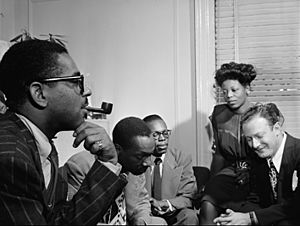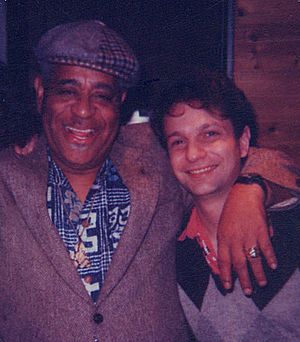Dizzy Gillespie facts for kids
Quick facts for kids
Dizzy Gillespie
|
|
|---|---|
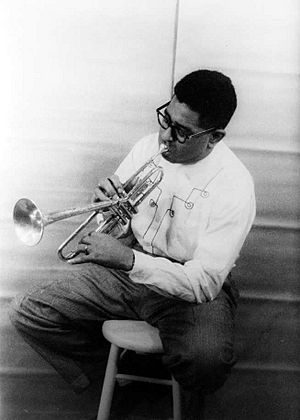
Dizzy Gillespie in 1955
|
|
| Background information | |
| Birth name | John Birks Gillespie |
| Born | October 21, 1917 Cheraw, South Carolina, U.S. |
| Died | January 6, 1993 (aged 75) Englewood, New Jersey, U.S. |
| Genres | Jazz |
| Occupation(s) | Musician, composer |
| Instruments | Trumpet |
| Years active | 1935–1993 |
| Associated acts | Charlie Parker, Cab Calloway |
John Birks "Dizzy" Gillespie (October 21, 1917 – January 6, 1993) was an American jazz trumpeter, bandleader, singer and composer.
Contents
Early life
Gillespie was born in Cheraw, South Carolina, the youngest of nine children of James and Lottie Gillespie. James was a local bandleader, so instruments were made available to the children. Gillespie's father died when he was only ten years old.
Gillespie taught himself how to play the trombone as well as the trumpet by the age of twelve.
He received a music scholarship to the Laurinburg Institute in North Carolina which he attended for two years before accompanying his family when they moved to Philadelphia.
Career
Gillespie's first professional job was with the Frank Fairfax Orchestra in 1935. After that, he joined the orchestras of Edgar Hayes and Teddy Hill, essentially replacing Roy Eldridge as first trumpet in 1937.
In 1939, Gillespie joined Cab Calloway's orchestra, with which he recorded one of his earliest compositions, the instrumental "Pickin' the Cabbage", in 1940. During his time in Calloway's band, Gillespie started writing big band music for bandleaders like Woody Herman and Jimmy Dorsey. He then freelanced with a few bands – most notably Ella Fitzgerald's orchestra, composed of members of the late Chick Webb's band, in 1942.
In 1943, Gillespie joined the Earl Hines band. Then, Gillespie joined the big band of Hines' long-time collaborator Billy Eckstine, and it was as a member of Eckstine's band that he was reunited with Charlie Parker, a fellow member. In 1945, Gillespie left Eckstine's band because he wanted to play with a small combo. A "small combo" typically comprised no more than five musicians, playing the trumpet, saxophone, piano, bass and drums.
Rise of bebop
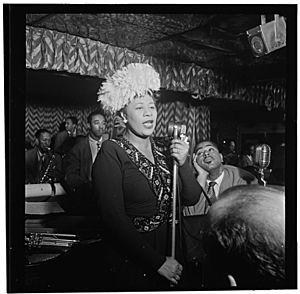
Bebop was known as the first modern jazz style. It was unpopular in the beginning. New musicians in the bebop era like Charlie Parker, Thelonious Monk, Bud Powell, Kenny Clarke, Oscar Pettiford, and Gillespie created a new vocabulary of musical phrases.
Gillespie compositions like "Groovin' High", "Woody 'n' You" and "Salt Peanuts" sounded radically different, harmonically and rhythmically, from the swing music popular at the time.
Gillespie taught many of the young musicians on 52nd Street, including Miles Davis and Max Roach, about the new style of jazz.
After his work with Parker, Gillespie finally put together his first successful big band. Gillespie and his band tried to popularize bop and make Gillespie a symbol of the new music. He appeared frequently as a soloist with Norman Granz's Jazz at the Philharmonic. He also headlined the 1946 independently produced musical revue film Jivin' in Be-Bop.
In 1956 Gillespie organized a band to go on a State Department tour of the Middle East which was extremely well received internationally and earned him the nickname "the Ambassador of Jazz". During this time, he also continued to lead a big band that performed throughout the United States and featured musicians including Pee Wee Moore and others. This band recorded a live album at the 1957 Newport jazz festival that featured Mary Lou Williams as a guest artist on piano.
Gillespie remained true to the bebop style for the rest of his career.
Afro-Cuban music
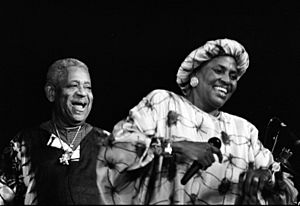
In the late 1940s, Gillespie was also involved in the movement called Afro-Cuban music. Afro-Cuban jazz is based on traditional Afro-Cuban rhythms. Gillespie helped develop and mature the Afro-Cuban jazz style.
Afro-Cuban jazz was successful because it never decreased in popularity and it always attracted people to dance to its unique rhythms. Gillespie's most famous contributions to Afro-Cuban music are the compositions "Manteca" and "Tin Tin Deo" (both co-written with Chano Pozo).
Later years
In the 1980s, Gillespie led the United Nation Orchestra. For three years Flora Purim toured with the Orchestra and she credits Gillespie with evolving her understanding of jazz after being in the field for over two decades. David Sánchez also toured with the group and was also greatly influenced by Gillespie. Both artists later were nominated for Grammy awards.
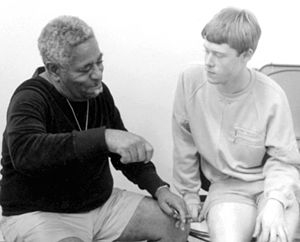
In 1989 Gillespie gave 300 performances in 27 countries, appeared in 100 U.S. cities in 31 states and the District of Columbia, headlined three television specials, performed with two symphonies, and recorded four albums.
Personal life
In August 1937 while gigging in Washington D.C., Gillespie met a young dancer named Lorraine Willis. Willis was not immediately friendly but Gillespie was attracted anyway. The two finally married on May 9, 1940.
They remained married until his death in 1993.
Dizzy Gillespie, a Bahá'í since 1968, was one of the most famous adherents of the Bahá'í Faith. Gillespie spoke about the Bahá'í Faith frequently on his trips abroad. He is honored with weekly jazz sessions at the New York Bahá'í Center in the memorial auditorium.
Death
Gillespie died on January 6, 1993 at age 75 from pancreatic cancer.
Gillespie had two funerals. One was a Bahá´í funeral at his request, at which his closest friends and colleagues attended. The second was at the Cathedral of St. John the Divine in New York open to the public where everyone can attend.
Interesting facts about Dizzy Gillespie
- Gillespie started to play the piano at the age of four.
- From the night he heard his idol, Roy Eldridge, play on the radio, he dreamed of becoming a jazz musician.
- He was nicknamed Dizzy because of how he acted during performances.
- Gillespie did not serve in World War II.
- Gillespie set new standards for trumpet players, moving American jazz from swing to 'bebop'.
- Together with Charlie Parker, he was a major figure in the development of modern jazz.
- In 1960, he was inducted into Down Beat magazine's Jazz Hall of Fame.
- In 1948, Gillespie was involved in a traffic accident when the bicycle he was riding was bumped by an automobile. After the accident, he could no longer hit the B-flat above high C.
- On January 6, 1953, at a party in a club in Manhattan, his trumpet's bell got bent upward in an accident. He liked the sound so much that he had a special trumpet made with a 45 degree raised bell. This became his trademark.
- During the 1964 United States presidential campaign the artist, with tongue in cheek, put himself forward as an independent write-in candidate. He promised that if he were elected, the White House would be renamed the Blues House.
- In 1971, Gillespie announced he would run again but withdrew before the election for reasons connected to the Bahá'í Faith.
- Gillespie published his autobiography, To Be or Not to Bop, in 1979.
- Gillespie was a vocal fixture in many of John Hubley and Faith Hubley's animated films, such as The Hole, The Hat, and Voyage to Next.
- Gillespie also had a guest appearance on The Cosby Show as well as Sesame Street and The Muppet Show.
- In 1982, Gillespie had a cameo appearance on Stevie Wonder's hit "Do I Do".
- He was crowned a traditional chief in Nigeria.
- Gillespie starred in a film called The Winter in Lisbon released in 2004.
- He has a star on the Hollywood Walk of Fame at 7057 Hollywood Boulevard.
Dizzy Gillespie quotes
- “The idea of life is to give and receive.”
- "I don't care much about music. What I like is sounds."
- "I think the idea is now for blacks to write about the history of our music. It's time for that, because whites have been doing it all the time. It's time for us to do it ourselves and tell it like it is."
- "The basic thing about jazz music is putting the notes to rhythm, not the other way around.... You can take just one note and put all kinds of different rhythms to the note and with just that one note everybody is clapping their hands and dancing and shouting."
Awards and honors
- Gillespie received the Ordre des Arts et des Lettres; France's most prestigious cultural award.
- In 1989, He was named Regent Professor by the University of California, and received his fourteenth honorary doctoral degree, this one from the Berklee College of Music.
- He was awarded the Grammy Lifetime Achievement Award the same year.
- In 1990, at the Kennedy Center for the Performing Arts ceremonies celebrating the centennial of American jazz, Gillespie received the Kennedy Center Honors Award and the American Society of Composers, Authors, and Publishers Duke Ellington Award for 50 years of achievement as a composer, performer, and bandleader.
- In 1993 he received the Polar Music Prize in Sweden.
- In 2002, Gillespie was posthumously inducted into the International Latin Music Hall of Fame for his contributions to Afro-Cuban music.
- He was honored on December 31, 2006 in A Jazz New Year's Eve: Freddy Cole & the Dizzy Gillespie All-Star Big Band at The John F. Kennedy Center for the Performing Arts.
Images for kids
-
Gillespie in concert, Deauville, Normandy, France, July 1991
See also
 In Spanish: Dizzy Gillespie para niños
In Spanish: Dizzy Gillespie para niños


